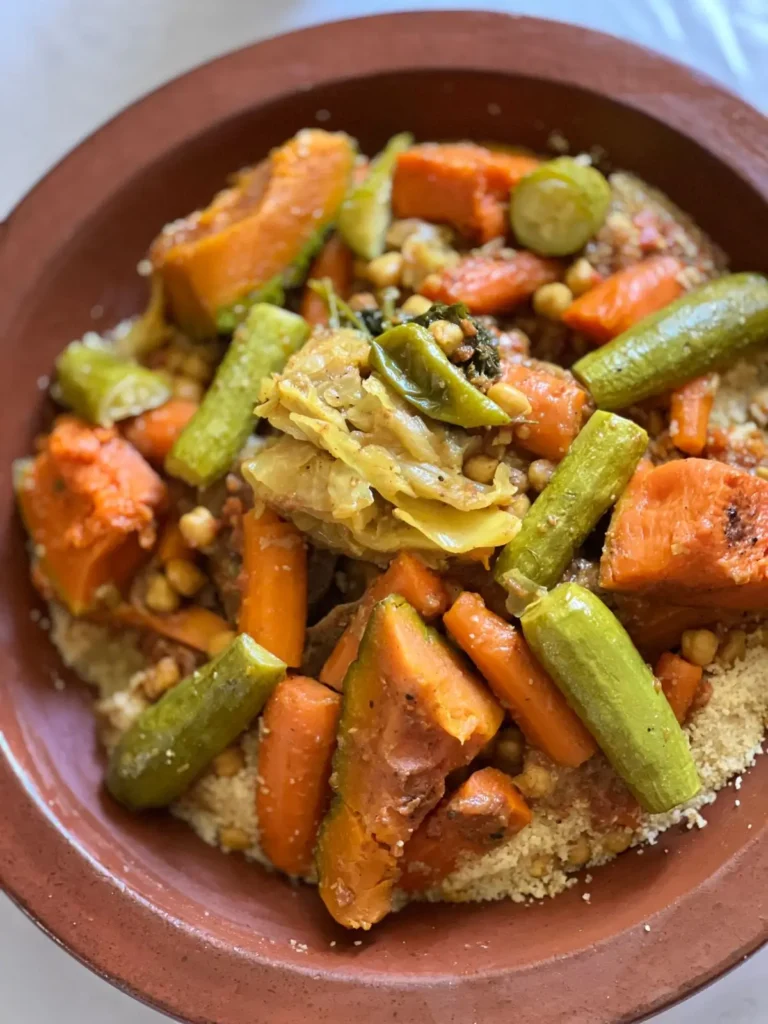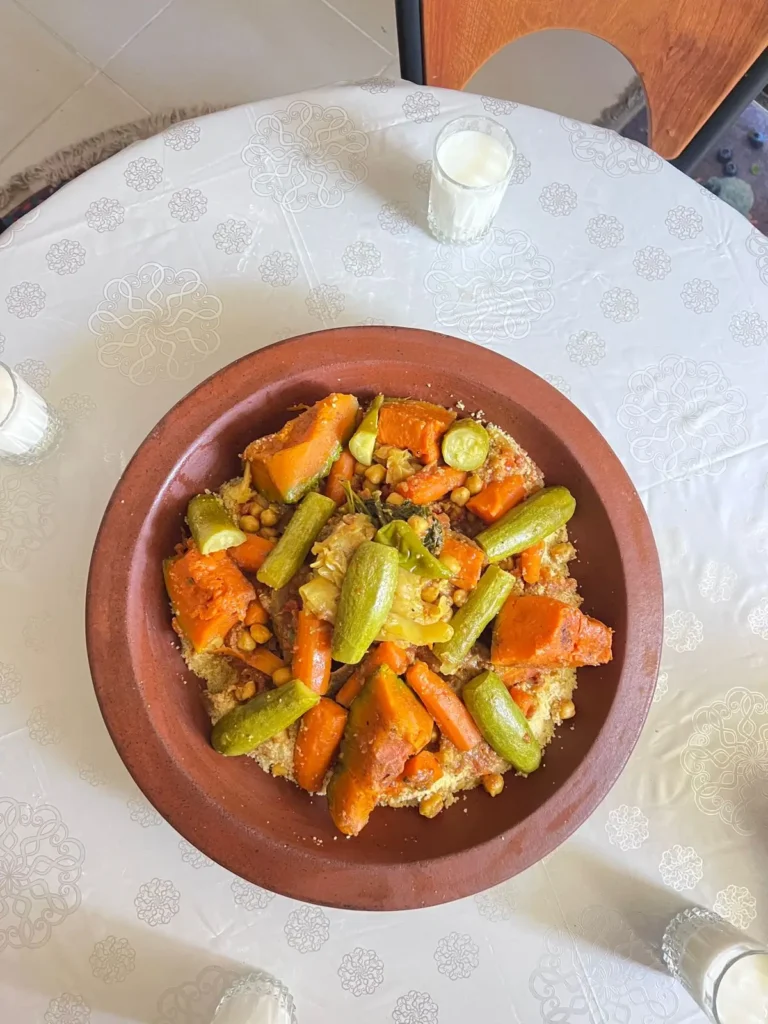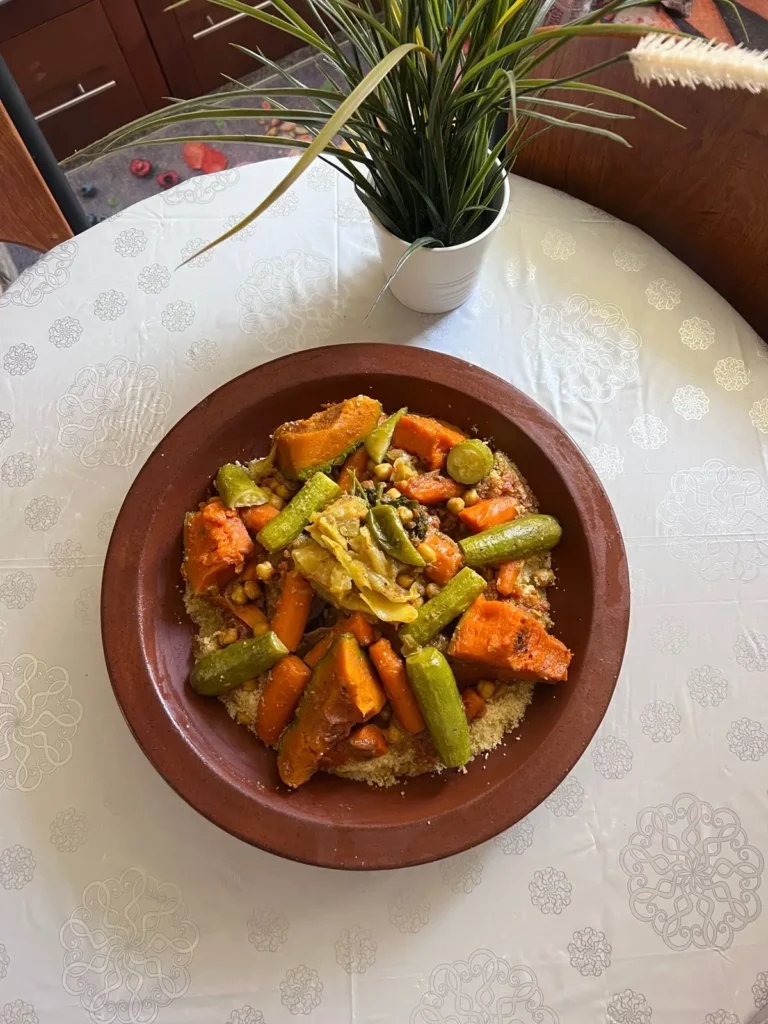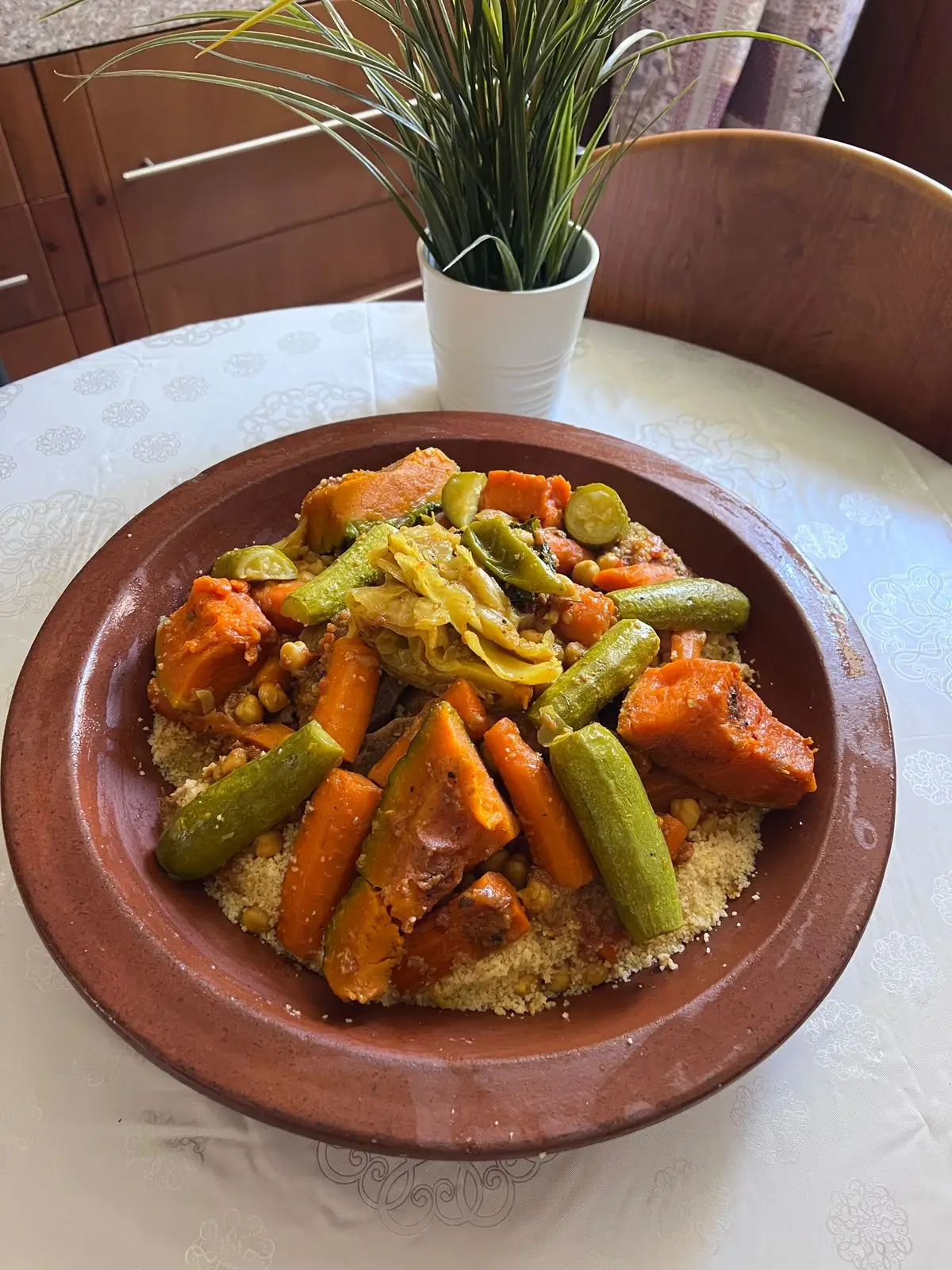There’s a kind of comfort that only a big bowl of warm, flavorful food can bring and for me, that comfort has always come from Moroccan couscous. The first time I tasted it, I was sitting at the dinner table of my dear friend Amina, whose mother had spent the whole afternoon preparing it from scratch. The smell of cinnamon, cumin, and slow-simmered vegetables filled the kitchen, and the couscous itself was like fluffy little clouds soaking up every drop of broth and love.
I didn’t grow up with couscous in my own kitchen, but once I learned how to make it, it quickly became part of my rotation especially when I want something wholesome, hearty, and packed with memory. Whether you’re brand new to North African flavors or looking for a cozy one-dish meal, Moroccan couscous will absolutely win your heart.
Table of Contents
What Makes This Couscous Recipe Special
This isn’t just any couscous recipe, it’s a dish that tells a story. Traditional Moroccan couscous is steamed (not boiled!), layered with tender root vegetables, and spiced with a subtle but warming blend of turmeric, cumin, cinnamon, and ginger. Often served on Fridays or special occasions, it’s not just food it’s a symbol of community, comfort, and care.
What sets this version apart is that it’s approachable. While it honors tradition, it’s simplified just enough for everyday cooking without losing the soul of the dish.
Whether you’re wondering what is couscous, or you’re familiar with boxed varieties, this guide will teach you how to cook couscous the way Moroccan grandmothers do with love.
Ingredients You’ll Need
Here’s everything you’ll need to create an authentic, heartwarming Moroccan couscous dish:
For the Couscous:
- 2 cups Moroccan-style couscous (fine-grain, not Israeli)
- 2 tablespoons olive oil or butter – To coat and separate grains
- 1 teaspoon salt
- 1½ cups boiling water or broth – To steam and flavor the couscous
For the Stewed Vegetables (The “Seven Vegetables”):
- 1 yellow onion, chopped
- 2 carrots, peeled and chopped
- 1 sweet potato, peeled and cubed
- 1 zucchini, sliced
- 1 small turnip or parsnip, peeled and chopped
- ½ small cabbage, chopped into wedges
- 1 cup canned chickpeas, drained and rinsed
- 2 tablespoons tomato paste
- 2 tablespoons olive oil
- 4 cups vegetable or chicken broth
Spices:
- 1 teaspoon ground cumin
- 1 teaspoon ground turmeric
- ½ teaspoon ground cinnamon
- ½ teaspoon paprika
- Salt and pepper to taste
Want to make it your own? You can substitute veggies based on what you have just aim for a variety of textures and colors.

How to Make Moroccan Couscous Step-by-Step
Here’s How to Cook Couscous with North African Flavor
1. Prepare the Couscous (Steam Method – Traditional Style)
- Place 2 cups of fine Moroccan couscous in a large, wide bowl or platter.
- Add 1 tablespoon of olive oil and 1 teaspoon of salt. Using your hands or a fork, gently rub the oil into the couscous to coat each grain. This helps prevent clumping.
- Pour 1½ cups of boiling water or broth evenly over the couscous. Let it sit undisturbed for 5–7 minutes, until the liquid is absorbed.
- After resting, fluff the couscous gently with a fork or your fingers to separate the grains.
- If using a steamer or couscoussier:
- Transfer the fluffed couscous to the steamer basket lined with cheesecloth or parchment.
- Steam over simmering water for 15–20 minutes.
- Remove, fluff again, and return to steam for another 10 minutes. This traditional method yields light, airy couscous.
Shortcut Option: You can skip the steaming and just use the boiled method if you’re short on time, but the texture won’t be quite as light and fluffy as the traditional version.
2. Cook the Vegetable Stew (Seven Vegetable Sauce)
- In a large pot or Dutch oven, heat 2 tablespoons of olive oil over medium heat.
- Add 1 chopped yellow onion and sauté for 3–5 minutes until translucent.
- Stir in 2 tablespoons tomato paste, 1 teaspoon cumin, 1 teaspoon turmeric, ½ teaspoon cinnamon, ½ teaspoon paprika, and salt and pepper to taste. Cook for 1–2 minutes to allow the spices to bloom.
- Add your firm vegetables first: 2 chopped carrots, 1 cubed sweet potato, and 1 chopped turnip or parsnip. Stir to coat with the spices.
- Pour in 4 cups of vegetable or chicken broth. Bring to a gentle boil, then reduce heat and simmer for 10 minutes.
- Add softer vegetables: 1 sliced zucchini, ½ small cabbage (wedged), and 1 cup canned chickpeas. Simmer for another 15–20 minutes until all vegetables are fork-tender.
Tip: Add more broth if you prefer a soupier stew, or let it reduce for a thicker sauce.
3. Assemble the Dish
- Transfer the fluffed couscous to a large serving platter and gently mound it in the center.
- Using a slotted spoon, arrange the vegetables on top of the couscous in colorful sections.
- Spoon some of the hot broth over the couscous to moisten and flavor it.
- Garnish with additional chickpeas, chopped fresh parsley, or a few golden raisins for sweetness if desired.
- Serve warm with extra broth on the side for guests to ladle over their portions.

Helpful Tips & Variations
- Use fine-grain Moroccan couscous, not the pearl-like Israeli variety.
- For added protein, top with stewed lamb, chicken, or grilled tofu.
- To enhance sweetness, toss in a handful of golden raisins while steaming the couscous.
- Want extra flair? Add toasted almonds or drizzle with harissa yogurt sauce.
Once you learn how to cook couscous this way, you’ll want to make it again and again.
What to Serve With Moroccan Couscous
Moroccan couscous is a meal on its own, but if you’re feeding a crowd or looking to round it out:
- Mint tea or ginger-lemon tea and the perfect one is Condensed milk – For a traditional Moroccan pairing
- Flatbread or pita – To soak up the stew
- Grilled chicken, lamb, or merguez sausage
- Fresh Mediterranean Cucumber Tomato Salad
Whether you’re hosting or feeding your family, couscous brings people together at the table.
Storage & Reheating Tips
- Store leftovers in an airtight container for up to 4 days.
- Reheat couscous gently in the microwave with a splash of broth or water.
- Freeze the vegetable stew separately in portions for future meals. Couscous itself freezes less well but can be made fresh in minutes.

Conclusion
Whether you’re exploring a new cuisine or rediscovering an old favorite, this Moroccan couscous recipe is a bowl full of comfort, culture, and care. It’s the kind of meal that fills your home with warmth and your heart with satisfaction.
If you try this recipe, I’d love to hear how it went! Drop a comment, rate it and make sure you Follow us on Facebook. Let’s keep cooking with soul one fluffy spoonful at a time.
FAQs About Moroccan Couscous
What is the difference between Moroccan couscous and Israeli couscous?
Moroccan couscous is much finer and steam-cooks quickly, while Israeli couscous (also called pearl couscous) is larger, chewier, and often boiled like pasta.
What are the seven vegetables in Moroccan couscous?
The traditional seven include: carrots, zucchini, cabbage, turnip, squash (or sweet potato), onions, and chickpeas. You can customize based on seasonality.
What is tagine vs couscous?
A tagine is a slow-cooked stew, often made with meat and spices, cooked in a clay pot of the same name. It’s often served over couscous, which acts as the starch.
Why is couscous important to Morocco?
Couscous is more than food in Morocco, it’s a symbol of hospitality, family, and Friday tradition. It’s often served after prayers and brings people together.

